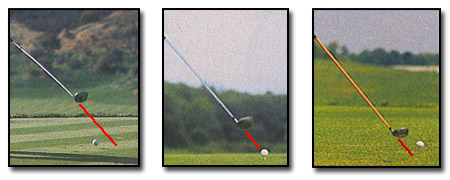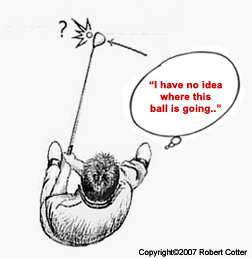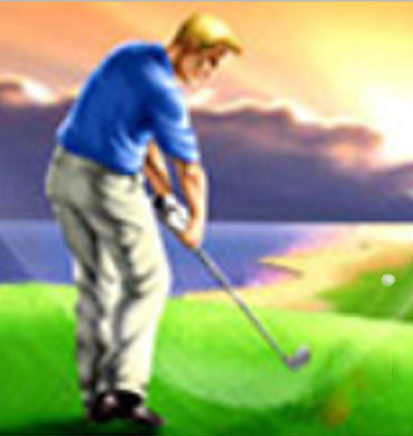“Use your natural body characteristics and avoid No Man’s Land“
A few weeks back, 26 year old Camilo Villegas shot a 66 during Sunday’s final round at the Tour Championship and took out Sergio Garcia in a playoff for his second win of 2008.
Those spectators who were on hand in the gallery got to see Camilo’s unique golf swing mechanics up close and personal. They also saw a lot of different looking golf swings.
That’s amazing when you consider the swing lasts 1 to 2 seconds for virtually every golfer. So let’s look at how the pros (and you) can hit the same great shots with different looking swings.
The golf swing is an equation with many variables. Alignment, posture, and application of force (to name a few) all contribute to the final quality of your golf shot and the repeatability of your swing. Some of these variables are established at address, while others are learned by trial and error.
Every golfer has individual physical characteristics and mannerisms given to them by their Maker. Some are tall and lean, others are more stout. Some golfers have inherent flexibility, others must rely on more complete, full body rotation in order to achieve a powerful impact.
Luckily, there are golfers of all shapes and sizes who have succeeded at the highest levels of golf.
Jim Furyk has won 13 PGA tournaments including the 2003 US Open and the 2007 Canadian Open with his “unorthodox” swing. He also won the decisive Ryder Cup singles match against Miguel Angel Jimenez back in September:

At #11 in the world rankings, he is on his way to a Hall of Fame career if he can put away another Major tournament in the next few years.
Did these top professionals like Jim (and great “young guns” like Camilo) somehow learn to resist their natural characteristics and manufacture a swing that closely resembled an ideal body type?
Of course not. They took their inherent characteristics and maximized them to their advantage (and reaped the rewards).
We all have our own unique “Brain-Muscle Memory” that will tend move the golf club on a particular path, particularly at the start of the back swing.
Furthermore, if there is memory then there is already a degree of repeatability in that motion. That repeatability is the very thing that can ultimately lead to a Repeating Golf Swing.
And in order to break 80 and go lower, you must have a Repeating Golf Swing.
To illustrate this further, look at these images of the first 1-2 feet of the back swing (the take away) of three different pro golfers, all Major Championship Winners:

1) In the left image, the player has lifted the club head and taken the club away to the outside of the Ball/Target Line.
2) In the middle image, another player moves the club back so that the shaft points at the Ball/Target Line during the take away.
3) In the right image, the player has moved the club head away lower and more to the inside of the Ball Target/Line.
This is Brain-Muscle Memory in action. And you can bet that if one or all of these players tried to re-route that club or change their natural tendency, chances are we would never have known their names.
So when it comes to your own tendencies or nuances:
Don’t fight them… Use them to your advantage!
If you tend to take the club a bit to the inside during your backswing, that’s fine (ever heard of Ray Floyd)?
Have a bit of a circle “outside” on the backswing ala Fred Couples?, no big deal..
After all, isn’t it impact that matters?
Now let’s look at how a golfer’s physical attributes and natural tendencies lead to patterns in his or her golf swing that become positive and automatic. And how resisting or ignoring good muscle memory leads to big problems in the swing.
Meet John. When John first took up the game, he found that as he started his back swing, his natural tendency became to take the club to the inside or a little bit around the body before breaking the club up on the swing plane. This was his tendency. He could repeat this move time and time again without much conscious thought. This is how his hands and arms wanted to move the club.
John could play quite well with this move and shoot in the 80’s. His low round was 77 and he was fairly content with his long game. With more short game practice, he was well on his way to breaking par .
Yes, he was fairly content…that is until he found an article in a popular golf magazine advocating a straight back move with the hands and golf club head. That’s the move that enabled a certain player to groove his golf swing and win a major championship.
Wow, he thought “if it worked for him, it should work for me. I may not turn pro but it will certainly help my game because every one says I take the club back to the inside”.
So off he goes to the practice range and starts pushing that club straight back along the Ball/Target Line at the start of the take away and popping it “into the catcher’s mitt” as the old adage goes. It feels strange at first but soon he is consciously repeating this move and getting the club to waist high.
But when he starts to finish his back swing and plane the club off, there are no longer any familiar golf sensations. All the familiar pressure points on the hands are gone! He can’t feel the club head like he used to with his former move. It is difficult to sense the end of the back swing now and his timing is off.
He manages a few good shots, but it is really the result of feeling out of position and consciously manipulating the clubface on the downswing to make decent contact.
Determined to stick with this “move” he decides to play his league match with his new technique. After all, it worked under pressure for the top pro in the article.
Disaster… he sprays the ball for 6 holes and then tries to switch back to the old “inside takeaway” with limited success. His mind and muscles are fighting each other and a repeatable pattern can’t take form:

Poor John is stuck in “No Man’s Land.”
Have you been stuck in No Man’s land? Or No Woman’s Land? Every golfer at any level has been there at one time or another. It ain’t fun.
When a golfer gets himself stuck in NML it becomes difficult if not impossible to return the club head through the ball without conscious manipulating of the hands and arms.
And with a typical golf down swing lasting 0.5 seconds, it is impossible to achieve solid impact consistently when this is your last resort.
Let me show you how to use the muscle memory you already have to build a reliable, repeating golf swing.
In the new professionally illustrated, 6th edition of “The Key To A Repeating Golf Swing”, I show you exactly how to stay out of No Man’s Land and deliver the club head right back through the ball at impact with tremendous power and control.

You’ll also learn:
1) Why “traditional” golf instruction fails to help the serious golfer.
2) What body part teaches you to feel and ingrain a Real Repeating Golf Swing.
3) An overlooked set-up (address) mistake 90% of golfers make, and the remedy.
4) How to start the back swing and get into perfect position at the top.
5) The Power “L”, what it is and how it leads to solid impact.
6) The 3 simple backswing checkpoints that set the stage for a powerful golf downswing.
7) My trademark Key to a Repeating Golf Swing that is shared by every great player, past and present.
8) Powerful visual aids that make your swing virtually automatic, and much more…
Thousands of golfers, from beginners to scratch players, have put The Key to work in their games and the results have been astounding.
I invite you to discover the common swing denominator shared by every great player, past and present. This year turn your body into a golfing machine and have the best golf season you’ve ever dreamed of with longer drives and lower scores.
And Remember, you will have Instant Access to my guaranteed Six (6) part instructional package which now includes my new ebook, “Putting Rebel – Conversation with a Putting Wizard”. A Hardcopy Version of the package is also available.
You’ll also be receiving a detailed, Personal Golf Ball Recommendation and Game Analysis report from a professional golf ball engineer to go with that new golf swing. This report now includes a proper driver loft assessment for your swing speed and handicap.
I look forward to the opportunity to work with you on your game – Robert C.
